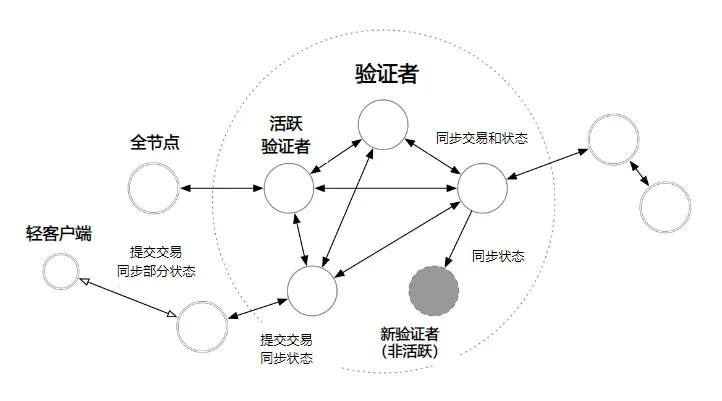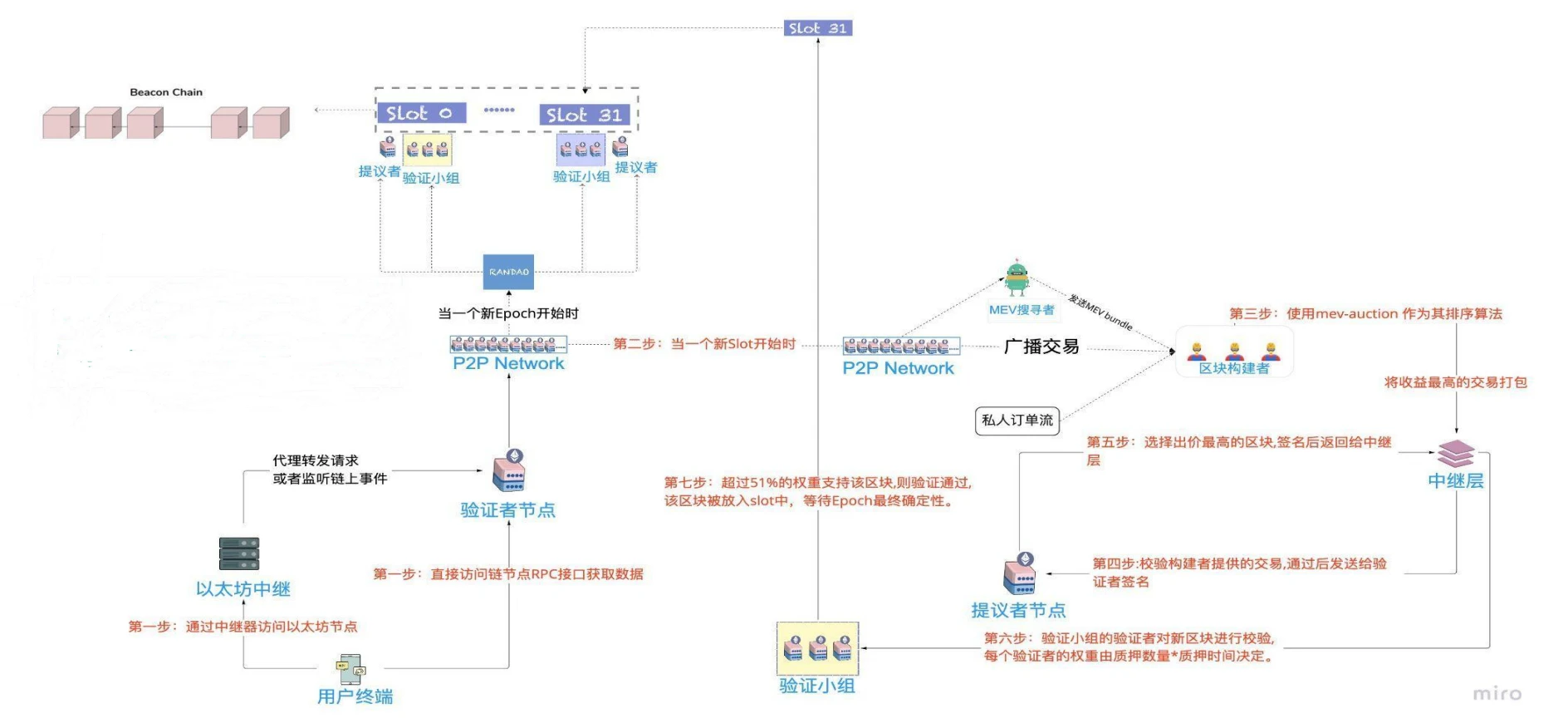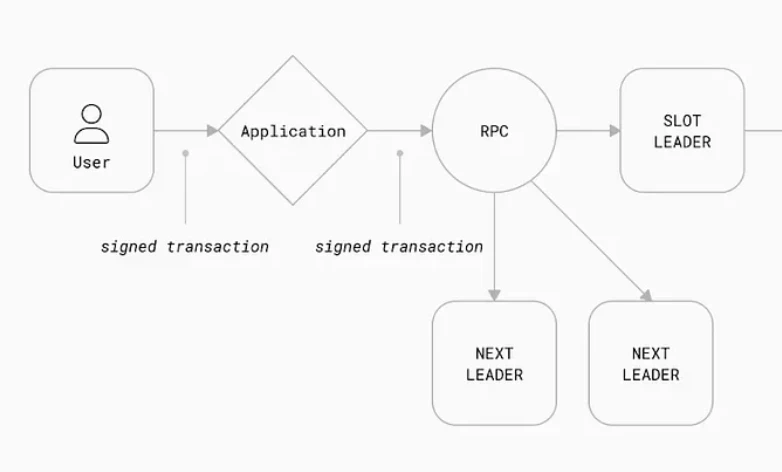Original author: Kevin, the Researcher at Movemaker
Comparing the technical differences between Move language, Aptos and other public chains may seem boring due to different depths of observation. A general analysis is bound to scratch the surface, and in-depth code will easily miss the forest for the trees. To quickly and accurately understand the difference between Aptos and other public chains, it is crucial to choose a suitable anchor point.
The author believes that the life cycle of a transaction is the best entry point. By analyzing the complete steps of a transaction from creation to final status update - including creation and initiation, broadcasting, sorting, execution and status update - we can clearly grasp the design ideas and technical choices of the public chain. Based on this benchmark, taking a step back can help us understand the core narratives of different public chains; taking a step forward, we can explore how to create market-attracting applications on Aptos.
As shown in the figure below, all blockchain transactions revolve around these five steps. This article will focus on Aptos, analyze its unique design, and compare the key differences between Ethereum and Solana.

Aptos: Optimistic Parallelism and High-Performance Design
Aptos is a public chain that emphasizes high performance. Its transaction lifecycle is similar to that of Ethereum, but it has been significantly improved through unique optimistic parallel execution and memory pool optimization. The following are the key steps of the transaction lifecycle on Aptos:
Creation and launch
The Aptos network consists of light nodes, full nodes, and validators. Users initiate transactions through light nodes (such as wallets or applications), and light nodes forward transactions to nearby full nodes, which then synchronize to validators.
broadcast
Aptos retains the memory pool, but after QuorumStore, the memory pool is not shared between them. Unlike Ethereum, its memory pool is not just a transaction buffer. After the transaction enters the memory pool, the system pre-sorts it according to rules (such as FIFO or Gas fees) to ensure that there is no conflict in the subsequent parallel execution of transactions. This design avoids the high hardware requirements of Solana to declare read and write collections in advance.
Sorting
Aptos uses the AptosBFT consensus. In principle, the proposer cannot freely sort transactions. AIP-68 gives the proposer the right to fill in delayed transactions. The memory pool pre-sorting has completed conflict avoidance in advance, and block generation relies more on the collaboration between validators rather than the proposer.
implement
Aptos uses Block-STM technology to achieve optimistic parallel execution. Transactions are assumed to be conflict-free and processed simultaneously. If a conflict is found after execution, the affected transactions will be re-executed. This method uses multi-core processors to improve efficiency and can reach 160,000 TPS.
Status Update
The validators synchronize the state and finality is confirmed through checkpoints, which is similar to Ethereums Epoch mechanism but more efficient.
The core advantage of Aptos lies in the combination of optimistic parallelism and memory pool pre-ordering, which not only reduces node performance requirements but also greatly improves throughput. As shown in the figure below, Aptos network architecture clearly supports this design:

Source: Aptos Whitepaper
Ethereum: Benchmarking Serial Execution
As the pioneer of smart contracts, Ethereum is the origin of public chain technology, and its transaction life cycle provides a basic framework for understanding Aptos.
Ethereum transaction life cycle
Creation and initiation : Users initiate transactions through wallets via relay gateways or RPC interfaces.
Broadcast : The transaction enters the public memory pool and waits for packaging.
Sorting : After the PoS upgrade, block builders package transactions according to the principle of profit maximization, and the relay layer bids and submits them to the proposer.
Execution : EVM processes transactions serially and updates state in a single thread.
Status update : Blocks must pass two checkpoints to confirm finality.
Ethereums serial execution and memory pool design limit performance, with a block time of 12 seconds/slot and low TPS. In contrast, Aptos has achieved a qualitative leap through parallel execution and memory pool optimization.

Solana: The Ultimate Optimization of Deterministic Parallelism
Solana is known for its high performance, and its transaction lifecycle is significantly different from Aptos, especially in terms of memory pool and execution methods.
Solana Transaction Lifecycle
Creation and initiation : Users initiate transactions through wallets.
Broadcast : There is no public memory pool, and the transaction is sent directly to the current and next two proposers.
Sorting : The proposer packs blocks based on PoH (Proof of History), and the block time is only 400 milliseconds.
Execution : Sealevel virtual machine uses deterministic parallel execution, and read and write sets need to be declared in advance to avoid conflicts.
Status update : BFT consensus fast confirmation.
The reason Solana does not use a memory pool is that the memory pool may become a performance bottleneck. Due to the absence of a memory pool and Solanas unique PoH consensus, nodes can quickly reach consensus on the order of transactions, avoiding the need for transactions to queue in the memory pool, and transactions can be completed almost instantly. However, this also means that when the network is overloaded, transactions may be discarded instead of waiting, and users need to resubmit.
In contrast, Aptos optimistic parallelism does not require the declaration of read and write collections, has a lower node threshold, and a higher TPS.

Source: shoal research
Two Paths to Parallel Execution: Aptos vs Solana
The execution of a transaction represents the update of the block status, which is the process of converting the transaction initiation instruction into a final state. How to understand this change? The node assumes that the transaction is successful and calculates its impact on the network status. This calculation process is execution.
Therefore, parallel execution in blockchain refers to the process of multi-core processors calculating the network status simultaneously. In the current market, parallel execution is divided into two types: deterministic parallel execution and optimistic parallel execution. The difference between these two development directions lies in how to ensure that parallel transactions do not conflict - that is, whether there is a dependency between transactions.
It can be seen that in the transaction life cycle, the timing of determining the conflict of parallel transaction dependencies determines the differentiation of the two development directions of deterministic parallel execution and optimistic parallel execution. Aptos and Solana have chosen different directions:
Deterministic parallelism (Solana): Before a transaction is broadcast, the read and write sets must be declared. The Sealevel engine processes conflict-free transactions in parallel based on the declaration, and conflicting transactions are executed serially. The advantage is high efficiency, but the disadvantage is high hardware requirements.
Optimistic parallelism (Aptos): Assuming that there is no conflict in the transaction, Block-STM executes in parallel and then verifies, and retries if there is a conflict. Pre-sorting the memory pool reduces the risk of conflict and reduces the burden on nodes.
For example: Account A has a balance of 100, Transaction 1 transfers 70 to B, and Transaction 2 transfers 50 to C. Solana confirms the conflict in advance through declarations and handles it in order; if Aptos finds that the balance is insufficient after parallel execution, it will readjust. The flexibility of Aptos makes it more scalable.
Optimistic parallelism uses memory pool to complete conflict confirmation in advance
The core idea of optimistic parallelism is to assume that transactions processed in parallel will not conflict, so the application does not need to submit a transaction statement before the transaction is executed. If a conflict is found during verification after the transaction is executed, Block-STM will re-execute the affected transactions to ensure consistency.
However, in practice, if we do not confirm in advance whether the transaction dependencies conflict, a large number of errors may occur during the actual execution, causing the public chain to run slowly. Therefore, optimistic parallelism does not simply assume that there are no conflicts in transactions, but avoids risks in advance at a certain stage, which is the transaction broadcast stage.
On Aptos, after transactions enter the public memory pool, they will be pre-sorted according to certain rules (such as FIFO and gas fees) to ensure that transactions within a block will not conflict when executed in parallel. It can be seen that the proposer of Aptos does not actually have the ability to sort transactions, and there is no block builder in the network. This transaction pre-sorting is the key to Aptoss optimistic parallelism. Unlike Solana, which requires the introduction of transaction declarations, Aptos does not require this mechanism, so the requirements for node performance are greatly reduced. In terms of network overhead to ensure that transactions do not conflict, the impact of Aptos joining the memory pool on TPS is far less than the cost of Solana introducing transaction declarations. Therefore, Aptos TPS can reach 160, 000, more than double Solana. The impact of transaction pre-sorting is that it is more difficult to capture MEV on Aptos, which has both advantages and disadvantages for users, and I will not go into details here.
Security-based narrative is where Aptos is headed
RWA: Aptos is actively promoting the tokenization of real assets and institutional financial solutions. Compared with Ethereum, Aptos Block-STM can process multiple asset transfer transactions in parallel to avoid delays in confirmation due to network congestion. On Solana or Sui, although the transaction speed is fast, the memory pool-free design may discard transactions when the network is overloaded, affecting the stability of RWA confirmation. Aptos memory pool pre-ordering ensures that transactions are executed in order, and the reliability of asset records can be maintained even during peak hours. RWA requires complex smart contract support, such as asset segmentation, profit distribution, and compliance checks. The modular design and security of the Move language make it easier for developers to build reliable RWA applications. In contrast, the complexity and vulnerability risks of Ethereum Solidity increase development costs, while Solanas Rust programming is efficient but requires a high learning curve for developers. Aptos eco-friendliness is expected to attract more RWA projects to land, forming a positive cycle. Aptos potential in the RWA field lies in the combination of security and performance. In the future, it can focus on cooperating with traditional financial institutions to put high-value assets such as bonds and stocks on the chain, and use the Move language to create a highly compliant tokenization standard. This safe + efficient narrative will allow Aptos to stand out in the RWA market.
In July 2024, Aptos officially announced that Ondo Finances USDY would be introduced into the ecosystem and integrated with major DEX and lending applications. As of March 10, the market value of USDY on Aptos was approximately US$15 million, accounting for approximately 2.5% of the total market value of USDY. In October 2024, Aptos announced that Franklin Templeton has launched the Franklin On-Chain U.S. Government Currency Fund (FOBXX) represented by the BENJI token on the Aptos Network. In addition, Aptos has worked with Libre to promote the tokenization of securities, bringing Brevan Howard, BlackRock, and Hamilton Lanes investment funds on-chain to enhance access for institutional investors.
Stablecoin payments: Stablecoin payments need to ensure the finality of transactions and the security of assets. Aptos Move language prevents double payments through a resource model to ensure the accuracy of each stablecoin transfer. For example, when users pay with USDC on Aptos, transaction status updates are strictly protected to avoid fund loss due to contract vulnerabilities. In addition, Aptos low Gas fees (thanks to high TPS cost sharing) make it extremely competitive in small payment scenarios. Ethereums high Gas fees limit its payment applications, and although Solana has low costs, the risk of transaction abandonment when the network is overloaded may affect the user experience. Aptos memory pool pre-sorting and Block-STM ensure the stability and low latency of payment transactions.
PayFi and stablecoin payments need to balance decentralization and regulatory compliance. AptosBFTs decentralized consensus reduces centralization risks, while its modular architecture supports developers to embed KYC/AML checks. For example, a stablecoin issuer can deploy a compliance contract on Aptos to ensure that transactions comply with local regulations without sacrificing network efficiency. This is better than Ethereums centralized relay model and also makes up for the potential compliance shortcomings of Solanas proposer-led model. Aptos balanced design makes it more suitable for financial institutions to enter.
Aptos potential in PayFi and stablecoin payments lies in the trinity of security, efficiency, and compliance. In the future, it will continue to promote the large-scale adoption of stablecoins, build a cross-border payment network, or cooperate with payment giants to develop an on-chain settlement system. High TPS and low cost can also support micropayment scenarios, such as real-time rewards for content creators. Aptos narrative can focus on the next generation payment infrastructure to attract two-way traffic from businesses and users.
Aptos security advantages - memory pool pre-ordering, Block-STM, AptosBFT and Move language - not only improve anti-attack capabilities, but also lay a solid foundation for the RWA and PayFi narratives. In the field of RWA, its high security and throughput support asset tokenization and large-scale transactions; in PayFi and stablecoin payments, low cost and high efficiency promote the implementation of real-world applications. Compared with Ethereums robustness but inefficiency and Solanas high speed but high threshold, Aptos opens up a new situation with a balanced approach. In the future, Aptos can use these advantages to shape the narrative of security-driven value network and become a bridge connecting the traditional economy and blockchain.
Summary: Aptos’ technical differences and future narrative
Through the perspective of the transaction lifecycle, we can clearly compare the differences in technical design between Aptos and Ethereum, Solana, and Sui, and reveal their respective core narratives. The following table summarizes the similarities and differences between the four in the broadcast, sorting, and execution stages, and Aptos unique advantages are also highlighted:

Aptos design strikes a clever balance between performance and security. Its memory pool pre-ordering combined with Block-STMs optimistic parallelism not only lowers the node threshold, but also achieves a high throughput of 160,000 TPS, surpassing Solanas deterministic parallelism and Suis object-level parallelism. Compared with Ethereums serial execution, Aptoss parallel capability brings a qualitative leap; and compared with Solana and Suis radical optimization of cutting off the memory pool, Aptos retains the pre-ordering mechanism to ensure the stability of the network under high load. This fast and stable approach, supplemented by the resource model of the Move language, gives Aptos higher security - whether it is resisting DDoS attacks or preventing contract vulnerabilities, it is better than Ethereums traditional architecture and Solanas high hardware dependence. Compared with Sui, which is also based on the Move language, the differentiation between Aptos and Sui is more inspiring. Sui is object-centric, pursuing extreme performance through DAG sorting and object-level parallelism, and is suitable for high-concurrency asset management scenarios; while Aptos is account-centric, relying on memory pools and optimistic parallelism, taking into account both versatility and ecological compatibility. This difference not only reflects the choice of technical paths, but also foreshadows the differentiation of application directions: Sui may be better at complex asset operations, while Aptos has an advantage in security-driven scenarios. It is based on this combination of security and performance that Aptos has shown great potential in the RWA and PayFi narratives. In the RWA field, Aptos high throughput supports large-scale asset on-chain, and recent cooperation with Ondo Finance (USDY market value of approximately US$15 million), Franklin Templeton and Libre has begun to bear fruit. In PayFi and stablecoin payments, Aptos low cost, high efficiency and compliance support micropayments and cross-border settlements, making it a strong candidate for the next generation payment infrastructure.
In summary, Aptos incorporates security and efficiency considerations into every link of the transaction life cycle, which is different from Ethereums robustness and inefficiency, Solanas high performance and high threshold, and Suis object-driven extreme optimization. In the future, Aptos can rely on the narrative of security-driven value network to connect traditional finance and blockchain ecology, continue to exert efforts in the fields of RWA and PayFi, and build a new public chain pattern with both trust and scalability.
About Movemaker
Movemaker is the first official community organization authorized by the Aptos Foundation and jointly initiated by Ankaa and BlockBooster, focusing on promoting the construction and development of the Aptos Chinese ecosystem. As the official representative of Aptos in the Chinese region, Movemaker is committed to building a diverse, open and prosperous Aptos ecosystem by connecting developers, users, capital and many ecological partners.
Disclaimer:
This article/blog is for informational purposes only and represents the personal opinions of the author and not Movemaker. This article is not intended to provide: (i) investment advice or investment recommendations; (ii) an offer or solicitation to buy, sell or hold digital assets; or (iii) financial, accounting, legal or tax advice. Holding digital assets, including stablecoins and NFTs, is extremely risky and may fluctuate in price and become worthless. You should carefully consider whether trading or holding digital assets is appropriate for you based on your financial situation. If you have questions about your specific situation, please consult your legal, tax or investment advisor. The information provided in this article (including market data and statistical information, if any) is for general information only. Reasonable care has been taken in the preparation of these data and charts, but no responsibility is assumed for any factual errors or omissions expressed therein.










